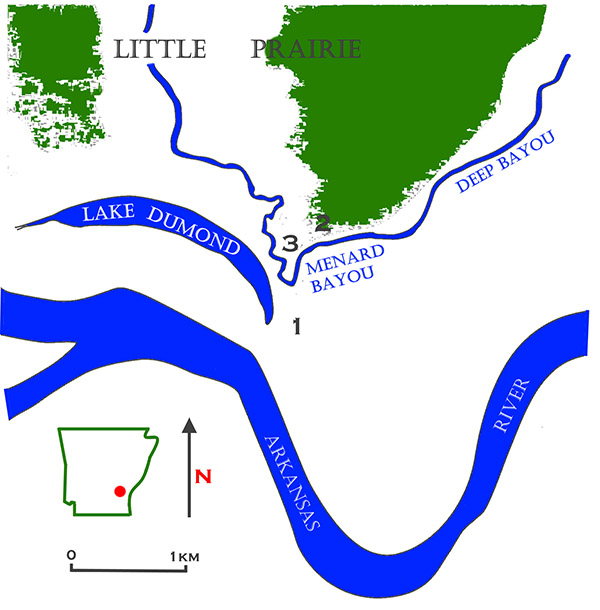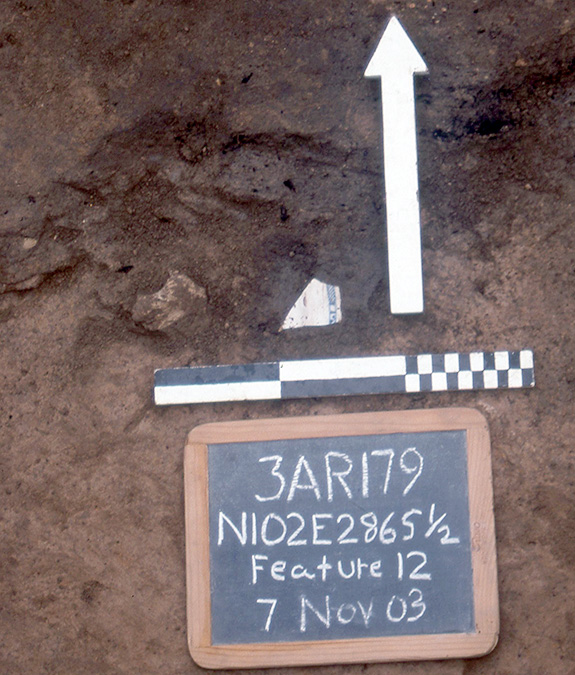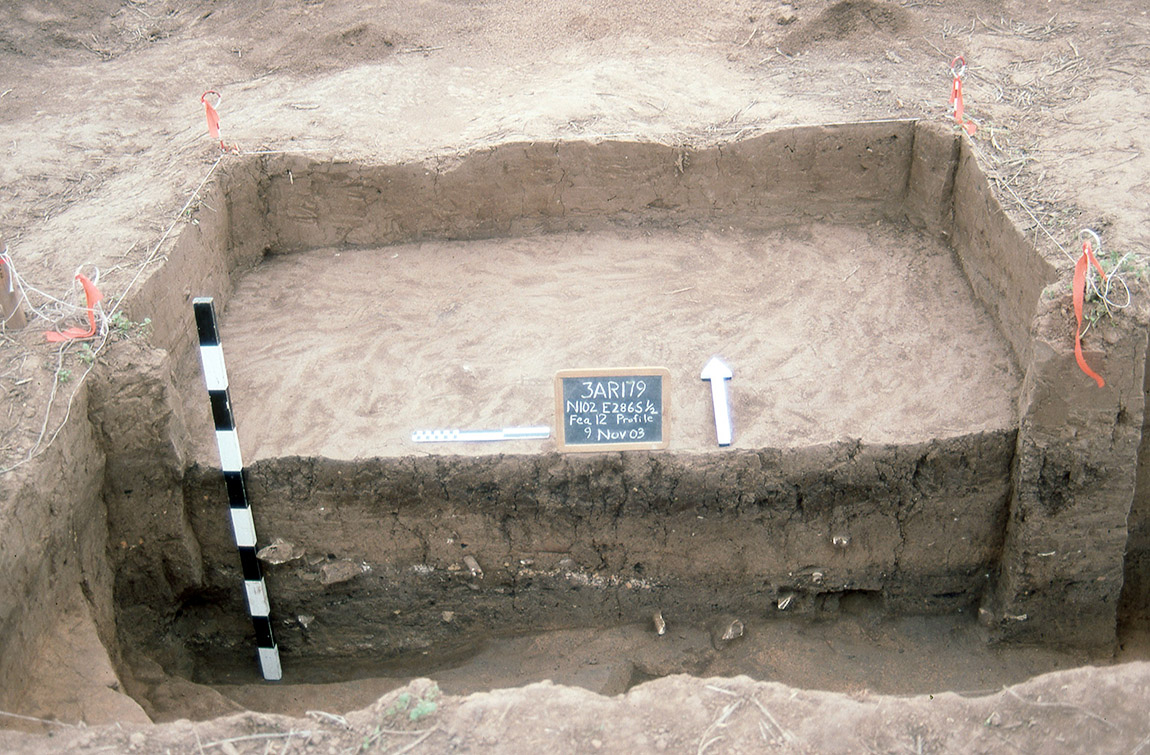By Andrew R. Beaupré, UAPB Research Station
Feature of the Month - October 2022
Feature 12, a suspected midden at Wallace Bottom is the October 2022 Feature of the Month.

Wallace Bottom (3AR179) is one of the sites in the Menard Locality along the Arkansas River in what is now Arkansas County (Figure 1). The site was first identified in the summer of 1998 during the Arkansas Archeological Society Training Program’s Site Survey Seminar under the direction of David R. Jeane (House 2002: 257). Due to the presence of artifacts of both Native American and European origin, the site was determined to likely represent a portion of the contact and colonial period Quapaw village of Osotouy, which was closely associated—both relationally and geographically—with Arkansas Post circa 1686 to 1749 (House 2002: 258).
Settlement by the Quapaw Nation and their antecedents predated European exploration and settlement in the Arkansas River Valley. Native settlements of the area were first visited by the DeSoto expedition in 1541–1542. French imperial pursuits for use of a water route through the interior of the continent drove the Marquette-Joliet Expedition to determine if the Mississippi River emptied into the Gulf of Mexico. Traveling south from the Great Lakes, the expedition visited Quapaw settlements before halting progress near the confluence of Mississippi and Arkansas Rivers in 1673 (Arnold 1991:5). The first French settlement in the area came at the behest of Henri de Tonti. Tonti was granted a seigneury along the Arkansas River by his commanding officer, René-Robert Cavelier, Sieur de La Salle. In 1686, Tonti settled six of his men at or near the Quapaw village of Osotouy (Arnold 1991:5). Tonti’s post at Osotouy was abandoned by 1699 and a more or less permanent French would not return to the area until 1721 (Arnold 2017:1-2). The French civilian and military population of Arkansas would rely on the Quapaw as military allies and trading partners through the remainder of the French colonial period.
Feature 12 represents a refuse pit, or midden, basically an eighteenth century garbage dump. What makes Feature 12 at Wallace Bottom so fascinating is the mixture of French and Native material in a single archeological context. Native made shell-tempered pottery, antler projectile points and burned daub from Quapaw home construction exists alongside French gunflints, musket balls, and faience tablewares (Figure 2). One particular artifact embodies the mixing of Native and European material culture: a partial base of a shell tempered pot still bears the stain from a European made metal object which oxidized in place over the last 300 years.


The story told by an ethnically mixed context such as Feature 12 is not always straightforward. The presence of European made artifacts indicate the feature must date from after culture contact. Archeologists use the term terminus post quem, which is Latin for "limit after which," to indicate the date after which a context dates. In other words, an archeological feature can only be as old as the newest artifact. Beyond the postcontact period date of the feature, who created it? Feature 12 might represent a location frequented by French people using Native artifacts, Native people using French artifacts, or a mix of Native and French peoples cohabitating. Further analysis of the specific artifacts associated to the feature can provide us with a better indication as to which one of these three scenarios is more likely.
Research relating to Feature 12 is ongoing. The faunal remains recovered from the feature, over 1,300 individual specimens, are currently being analyzed by Dr. Terrance J. Martin. Dr Martin is emeritus curator of Anthropology at the Illinois State Museum and a noted expert faunal analyst. Analysis of these animal bones in association with previous work on ethnobotanical remains from Wallace Bottom will offer key information on contact period lifeways (Nordine et al 2016). Members of the Arkansas Archeological Survey are collaborating with outside researchers on a forthcoming article centered on the foodways at Wallace Bottom.
One final note, Feature 12 may still have information to share with us. When excavated in 2003, the feature was bisected, meaning that half of the material still lies in situ on the margins of Lake Dumond for future archeologists to investigate (Figure 4).

References
Arnold, Morris Shepperd
1991 Colonial Arkansas 1686-1804: A Social and Cultural History. University of Arkansas Press, Fayetteville.
2017 The Arkansas Post of Louisiana. University of Arkansas Press, Fayetteville.
House, John H.
2002 Wallace Bottom: A Colonial-Era Archaeological Site the Menard Locality, Eastern Arkansas. Southeastern Archaeology. 21(2): 257-269.
2013 Native American Material Culture from the Wallace Bottom Site, Southeastern, Arkansas. Southeastern Archaeology 32: 54-69
Nordine, Kelsey O., Gayle J. Fritz and Jocelyn C. Turner
2016 “In short, they gave us what they had”: Plant Remains from the Wallace Bottom Site, Arkansas. In Research, Preservation, Communication: Honoring Thomas J. Green on his Retirement from the Arkansas Archeological Survey, Mary Beth Trubitt, editor. Arkansas Archeological Survey Research Series No. 67.
Feature of the Month Series
Archeological features are elements or structures that are nonportable or cannot be easily removed from a site (such as a wall or a post hole). Archeologists document archeological features extensively in the field to record what will otherwise be destroyed in the process of excavation. The records of these features are often all that is left at the end of an excavation. Excellent record keeping is necessary for these features to provide insight into the archeological record and site formation.
In this series, we present interesting and important archeological features that have helped archeologists to better or more fully understand the sites on which they were working. New features will be added monthly. Find the list of features here.
